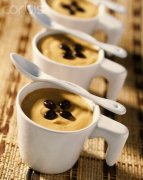Roasting roasted coffee
The average chemical composition of raw coffee beans is as follows:
Water 12%, nitrogen 12%, fat 12%, sugar and dextrin 10%, other non-nitrogen 18%, dust 4%, tannin 6.7%, caffeine 1.2%, coffee essential oil 0.1%.
Of course, these figures are not fixed, and the quantities of some of the ingredients vary considerably, which is why each coffee is so different. Roasting involves heating the beans to 200 - 220 degrees Celsius in a large, specially designed container and stirring them constantly for up to 20 minutes.
The process ends when the beans turn dark brown. In many countries, roasting ends when the beans are light brown, but the timing of all these stops depends on taste.
During roasting, the beans lose about 18-22% of their weight, which is actually due to a number of factors: water is evaporated, sugar is caramelized, tannins and fat are also reduced. An important aspect of baking is that the inside of the beans should be baked the same as the outside. During roasting, the beans increase in volume by up to 60%, resulting in a significant reduction in specific gravity. Coffee essential oils in beans run to the surface and develop an aromatic element, coffee (coffeone) contains more than 600 chemical components, giving coffee a charming flavor. In any case, roasting must not "push" too much in order to improve the aroma, because this may cause many components in the coffee to volatilize, thus risking reducing the aroma.
Cooling: Once the beans leave the roaster, they must be cooled immediately to avoid the self-baking effect causing the beans to be deeper than the proper roasting degree they have reached. There are three ways to cool beans:
1)Water-cooling: Spray water on hot freshly baked beans to cool them. Since coffee absorbs water easily, this process significantly increases the specific gravity of the beans.
2)cooling with ordinary air
3)cooled with chilled air
Important Notice :
前街咖啡 FrontStreet Coffee has moved to new addredd:
FrontStreet Coffee Address: 315,Donghua East Road,GuangZhou
Tel:020 38364473
- Prev

The eight stages of coffee roasting
Eight stages of roasting: Professional coffee roasting is usually divided into the following eight stages. 1. Light Roast: degree of baking; very light baking, also known as light baking. The lightest degree of roasting of all stages, the beans have a light cinnamon color on the surface, and their taste and aroma are insufficient to make them almost inedible. Usually used in testing, rarely used
- Next

Where does the bitter taste of coffee come from?
The researchers identified two compounds associated with the bitterness of coffee to add milk and sugar to a steaming cup of coffee, a sign that many people start a new day. Although this is done to reconcile the bitterness of the drink, the reason why coffee makes us frown has puzzled scientists for decades. Today, by identifying two types of breakfast coffee that are either mild or mild,
Related
- Beginners will see the "Coffee pull flower" guide!
- What is the difference between ice blog purified milk and ordinary milk coffee?
- Why is the Philippines the largest producer of crops in Liberia?
- For coffee extraction, should the fine powder be retained?
- How does extracted espresso fill pressed powder? How much strength does it take to press the powder?
- How to make jasmine cold extract coffee? Is the jasmine + latte good?
- Will this little toy really make the coffee taste better? How does Lily Drip affect coffee extraction?
- Will the action of slapping the filter cup also affect coffee extraction?
- What's the difference between powder-to-water ratio and powder-to-liquid ratio?
- What is the Ethiopian local species? What does it have to do with Heirloom native species?

